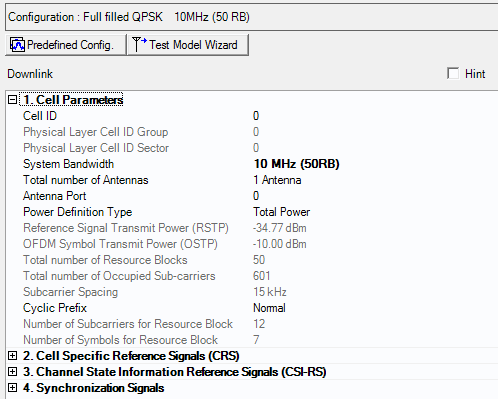
Additional Downlink parameters are described in Cell Specific Reference Signal (Basic LTE-A FDD Downlink), Synchronization Signals (Basic LTE-A FDD Downlink), and Channel State Information Reference Signal Parameters (Basic LTE-A FDD Downlink).

|
1. Cell Parameters |
|---|
Range: 0 to 503
Default: 1
Enter a value for the Cell ID. The software sets the values in the and cells based on the entry.
Cell ID = [(3 x Physical Cell ID Group) + Physical Cell ID Sector]. See 3GPPTS 36.211.
Range: 0 to 167
Default: 0
The software sets this value based on the entry for the .
Cell ID = [(3 x Physical Cell ID Group) + Physical Cell ID Sector].
See 3GPPTS 36.211.
Choice: 0 | 1 | 2
Default: 0
The software sets this value based on the entry for the .
Cell ID = [(3 x Physical Cell ID Group) + Physical Cell ID Sector].
See 3GPPTS 36.211.
Choice: 1.4 MHz (6RB) | 3 MHz (15RB) | 5 MHz (25RB) | 10 MHz (50RB) | 15 MHz (75RB) | 20 MHz (100RB)
Default: 10 MHz (50RB)
Double-click or use the drop-down menu to set the system bandwidth and number of Resource Blocks (RB). When you select a system bandwidth, the software automatically adjusts the value in the cell and the cell.
The resource blocks and some parameters are reconfigured by changing the System Bandwidth parameter, similar to when a is executed.
Choice: 1 Antenna | 2 Antennas | 4 Antennas | 8 Antennas
Default: 1 Antenna
In multi-antenna configurations, specify the total number of physical antenna port configurations to be used for the downlink transmission for this cell. The combination of the Total number of Antennas and Number of CRS Antenna Ports determines the resource elements that are reserved for Cell-specific reference signals, as described in 3GPP TS36.211.
For multiple signal generator configurations, set the Channel State parameter in the Fading section of the Carrier node to On to make this cell active. When the channel state is off, you must change the number of signal generators (for example, Quick Setup M x 1, M x 2, M x 4) to change the number of BS antennas.
MIMO pre-coding is not applied in the Basic carrier, use an Advanced carrier for generating a signal with MIMO pre-coding applied.
Choice: 0 | 1 | 2 | 3 | 4 | 5 | 6 | 7
Default: 0
In multi-antenna configurations, specify the physical antenna port to be used for transmitting the downlink signal. The available selections are determined by the Total Number of Antennas setting. The number of Antenna Ports should be equal to or less than the Total Number of Antenna Ports.
With a Basic carrier, only one antenna port is available for signal transmission. The combination of the Antenna Port setting and the Total number of Antennas setting determines the resource elements that are reserved for reference signals as described in 3GPP TS 36.211.
MIMO pre-coding is not applied in the Basic carrier, use an Advanced carrier for generating a signal with MIMO pre-coding applied.
The value in this cell is set by the software based on the setting.
The value in this cell is set by the software based on the setting. The center subcarrier is not used for downlink transmission, so the number of transmitted subcarriers is one less than the number of occupied subcarriers.
Default: 15 kHz
Displays the subcarrier spacing for the downlink. Only the 15 kHz subcarrier spacing is supported in this release.
Choice: Normal | Extended
Default: Normal
Double-click or use the drop-down menu to select a or cyclic prefix. The software sets the based on the cyclic prefix selection.
Default: 12
Displays the number of consecutive subcarriers in a downlink resource block.
Default: 7 for Cyclic Prefix; 6 for Cyclic Prefix
Displays the number of consecutive OFDM symbols in a downlink slot. The software sets the Number of Symbols for Resource Block based on the Cyclic Prefix selection.
Choice: Total Power | RSTP
Default: Total Power
Double-click or use the drop-down menu to select the power definition type for the primary cell.
The power definition type for secondary cells is automatically set same type of the primary cell and set the value as read-only.
In multiple carrier case, Power Definition Type parameter in each carrier should be same.
If Total Power is selected, power reference is Amplitude parameter on Instrument node. In single/multiple carrier and Total Power case, RSTP and OSTP are automatically calculated by Amplitude parameter on Instrument node, Power parameter on Component Carrier and each carrier signal settings.
If RSTP is selected, power reference is RSTP. In single/multiple carrier and RSTP case, Amplitude parameter on Instrument node, Power parameter on Component Carrier and OSTP are automatically calculated by RSTP and each carrier signal settings. In this case, Power parameter on Component Carrier is set read-only.
If uplink and downlink carriers are mixed as multiple carrier, correct RSTP calculation is not available.
Range: -15.00 to -144.00 dBm
Default: -40.79 dBm
Enter the Reference Signal Transmit Power in dBm, when the Power Definition Type is RSTP. Otherwise displays the Reference Signal Transmit Power in dBm and the value is updated after generation.
In the case Power Definition Type is Total Power, RSTP is automatically calculated by Amplitude parameter in Instrument, Power parameter in Component Carrier and each carrier signal settings.
In the case Power Definition Type is RSTP, Amplitude parameter in Instrument and Power parameter in the Component Carrier is automatically calculated and set the value as read-only.
Available setting range and step depends on hardware.
See 3GPP TS 36.141 for more information.
This parameter is set by the software.